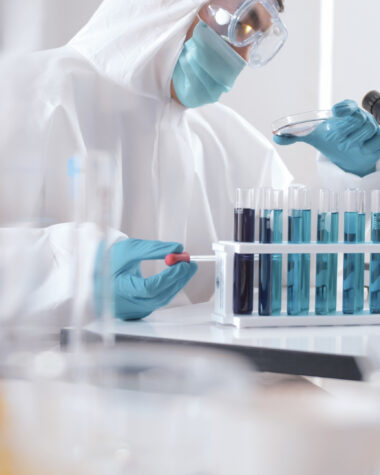Aldeyra Therapeutics Inc. (NASDAQ:ALDX) is a Massachusetts-based clinical-stage biotechnology company focused on discovering and developing novel therapies designed to treat immune-mediated and inflammatory diseases. Founded in 2004 and headquartered in Lexington, the company has built its scientific foundation on targeting Reactive Aldehyde Species (RASP) — harmful metabolic byproducts that cause and amplify inflammation across a broad range of ocular and systemic diseases. Aldeyra’s proprietary RASP-modulating technology is aimed at restoring immune balance without broadly suppressing the immune system, a unique mechanism that differentiates it from traditional anti-inflammatory or immunosuppressive drugs. This scientific approach positions Aldeyra at the intersection of ophthalmology and immunology, addressing conditions with significant unmet medical needs.
The company’s lead investigational therapy, reproxalap, represents the cornerstone of Aldeyra’s clinical strategy. Developed initially for dry eye disease and allergic conjunctivitis, reproxalap has demonstrated the potential to reduce ocular inflammation through RASP inhibition, offering a new pathway for symptom relief and disease control. After several late-stage clinical trials, Aldeyra submitted a Biologics License Application (BLA) to the U.S. Food and Drug Administration (FDA) for reproxalap, targeting one of the largest ocular treatment markets in the world. Though the regulatory process has faced setbacks — including a Complete Response Letter requesting additional efficacy data — Aldeyra has since resubmitted the application, with the FDA setting a new Prescription Drug User Fee Act (PDUFA) target date of December 16, 2025. A potential approval would mark a major milestone, transforming the company from a development-stage biotech into a commercial entity.
Beyond reproxalap, Aldeyra’s pipeline extends into other high-value therapeutic areas. The company is developing ADX-629, an orally administered RASP inhibitor for systemic inflammatory conditions such as psoriasis, COVID-19-associated inflammation, and Sjögren-Larsson Syndrome. Another candidate, ADX-2191, is being studied for rare retinal diseases and oncology-related indications, including primary vitreoretinal lymphoma. By leveraging the same core RASP modulation technology, Aldeyra aims to create a versatile platform applicable to multiple inflammatory disorders, positioning itself for long-term growth in both ophthalmic and systemic disease markets.
Aldeyra’s business model reflects the inherent volatility and high-risk, high-reward nature of the biotechnology sector. Without an approved product yet, the company’s revenues primarily stem from research grants and strategic collaborations, while operating expenses remain concentrated in research and development. As of mid-2025, Aldeyra reported a market capitalization of approximately $320 million, with institutional investors holding nearly 60% of its shares. Its financial sustainability depends heavily on successful regulatory outcomes, timely partnerships, and access to capital markets — common characteristics of early-stage biotech firms navigating the path to commercialization.
The company’s management team, led by CEO Dr. Todd Brady, combines expertise from the pharmaceutical, academic, and financial sectors, steering Aldeyra through the complex regulatory landscape that defines late-stage biotech development. Their vision centers on addressing chronic inflammation at its root cause, potentially offering patients disease-modifying therapies rather than symptomatic relief alone. With a proprietary technology platform, multiple ongoing clinical trials, and a growing intellectual property portfolio, Aldeyra Therapeutics continues to advance its mission to develop innovative treatments that can change the course of inflammatory and immune-mediated diseases worldwide.
Aldeyra’s Momentum Stalls as Technical Weakness Signals Investor Caution
Aldeyra Therapeutics (NASDAQ: ALDX), a small-cap clinical-stage biotech focused on ocular and inflammatory diseases, is showing renewed signs of market weakness. As of mid-October 2025, its stock price has fallen below the critical 50-day moving average of $5.42, trading as low as $5.36 before closing at $5.39. This technical breach typically signals growing investor uncertainty and could foreshadow further downside if sentiment continues to erode. Despite short-term rebounds following its Q2 earnings report, where Aldeyra posted a narrower-than-expected loss of $0.16 per share versus consensus estimates of -$0.21, the market has failed to reward the beat, suggesting skepticism over the company’s long-term execution and regulatory prospects.
Adding to the concern is insider activity. In August 2025, Stephen Machatha, a key insider, sold 22,073 shares at an average price of $5.15, reducing his ownership stake by 9.05%. Insider selling in a small-cap biotech often signals either valuation concerns or management’s caution about upcoming catalysts. Even though Aldeyra’s leadership has downplayed this move, it has added a layer of doubt for retail investors already wary of the stock’s volatility.

CHECK THIS OUT: Tiziana (TLSA) Surges 143% in 2025 and Immuneering (IMRX) Reports 86% 9-Month Survival in Pancreatic Cancer.
Analyst Ratings and Investor Sentiment Show Mixed Confidence
The analyst community remains divided on Aldeyra’s outlook. According to MarketBeat data, two analysts currently rate ALDX as a Buy, one assigns a Hold, and one issues a Sell, producing a consensus rating of “Hold” with an average price target of $9.50. While this target implies nearly 80% upside from current levels, the skepticism is grounded in the company’s turbulent clinical and regulatory history. Notably, Weiss Ratings reissued a “Sell (E+)” rating in October, signaling that risk-adjusted returns may not justify holding through upcoming catalysts, particularly as Aldeyra’s lead candidate, reproxalap, faces renewed regulatory scrutiny ahead of its December 2025 FDA decision.
The stock’s technical behavior also reinforces this caution. With its 200-day moving average at $4.03, the current price action hovering just above that level shows how fragile market confidence remains. In the absence of new catalysts, this setup exposes ALDX to sharp swings, particularly in a volatile biotech environment where retail speculation often outweighs fundamentals.
Eroding Confidence Despite Earnings Beat and Institutional Support
Despite a temporary boost from its better-than-expected Q2 2025 earnings, Aldeyra’s financials remain stretched. The company’s market capitalization of approximately $323 million and P/E ratio of -6.34 underscore its pre-revenue status and dependence on external funding. Institutional investors like Invesco Ltd., Wellington Management, and Strs Ohio have increased or initiated stakes this year, bringing institutional ownership to 59.7%. However, such positions may be opportunistic and short-term, often built around speculative pre-FDA movements rather than long-term confidence in the company’s fundamentals.
The real concern lies in Aldeyra’s limited cash runway. With no approved products generating revenue, the firm relies entirely on capital raises to sustain operations. Continued clinical delays or regulatory pushbacks—especially regarding reproxalap or ADX-629—could force the company to issue additional equity at unfavorable prices, diluting existing shareholders. The biotech’s negative earnings per share trajectory (expected -0.92 EPS for FY2025) suggests profitability remains years away, if ever.
Regulatory Overhang and Reproxalap’s Uncertain Path Forward
The biggest weight on Aldeyra’s valuation remains regulatory uncertainty. After receiving an FDA Complete Response Letter (CRL) earlier this year for reproxalap, the agency requested additional clinical evidence to confirm the drug’s efficacy in dry eye disease. Although Aldeyra has since resubmitted its Biologics License Application (BLA) with an updated dataset, the delay—pushing the PDUFA goal date to December 16, 2025—has reset investor expectations and injected new skepticism into the approval timeline.
The challenge is not only scientific but strategic. The dry eye disease market is already dominated by major players such as Restasis (Allergan), Xiidra (Bausch + Lomb), and Eysuvis (Alcon). Even if reproxalap receives approval, its commercial viability remains questionable unless it can demonstrate significant superiority in efficacy, tolerability, or cost efficiency. Analysts warn that Aldeyra’s limited marketing infrastructure and lack of commercialization experience could prevent it from competing effectively against these entrenched brands.
Insider and Institutional Dynamics Reflect a Lack of Conviction
The recent insider sale by Machatha amplifies concerns that even within Aldeyra’s leadership, confidence in short-term stock performance is wavering. With insiders collectively holding just 9.6% of total shares, alignment between management and shareholders appears weak. Historically, biotech firms with stronger insider ownership demonstrate greater resilience during regulatory turbulence, as insiders tend to buy on weakness. The opposite trend here may deter long-term institutional holders from maintaining or increasing positions, especially given the speculative nature of Aldeyra’s pipeline.
Meanwhile, institutional activity reflects short-term positioning rather than strategic conviction. Large inflows from Invesco and Wellington appear to be part of broader biotech exposure strategies rather than specific bets on Aldeyra’s science. These funds are likely to rotate quickly out of positions if regulatory or market sentiment turns negative before December.
Valuation Fragility and Broader Market Risks
Trading at just over $5 per share, Aldeyra’s market value reflects not optimism but uncertainty. The company has repeatedly faced steep declines following each regulatory setback, with shares plunging nearly 70% earlier this year when the FDA rejected its first BLA submission. That collapse underscores how heavily investor sentiment hinges on a single binary outcome. If the December FDA decision disappoints—or is delayed again—the downside could be severe, potentially erasing recent gains and pushing shares back toward the $3 range seen in early 2025.
Moreover, the broader biotech environment remains challenging. With the NASDAQ Biotech Index under pressure and risk appetite subdued, small-cap biotechs like Aldeyra are struggling to attract capital. Rising interest rates and tighter liquidity further reduce speculative inflows, increasing the risk that even minor disappointments will trigger large selloffs.
Conclusion: Aldeyra’s Short-Term Rally Masks Long-Term Instability
Aldeyra Therapeutics remains a classic case of high-risk, high-reward investing—but with risk currently far outweighing the reward. Its fall below the 50-day moving average, insider selling, uncertain regulatory timeline, and dilution risk all point toward a fragile setup heading into 2026. While bulls highlight the potential of reproxalap as a first-in-class therapy targeting Reactive Aldehyde Species (RASP) pathways, the repeated FDA delays and weak insider confidence suggest the company still faces steep regulatory and financial hurdles.
Unless Aldeyra delivers an unequivocal FDA approval by December—and follows through with credible commercialization plans—the stock may struggle to sustain its current valuation. For now, ALDX looks more like a speculative trade than a long-term investment, and investors should tread carefully as the clock ticks toward yet another high-stakes regulatory decision.
READ ALSO: Saudi Arabia Wants CEL-SCI (CVM)’s Multikine Now! and Aligos Therapeutics (ALGS) Doubles Cash to $122.9M.








